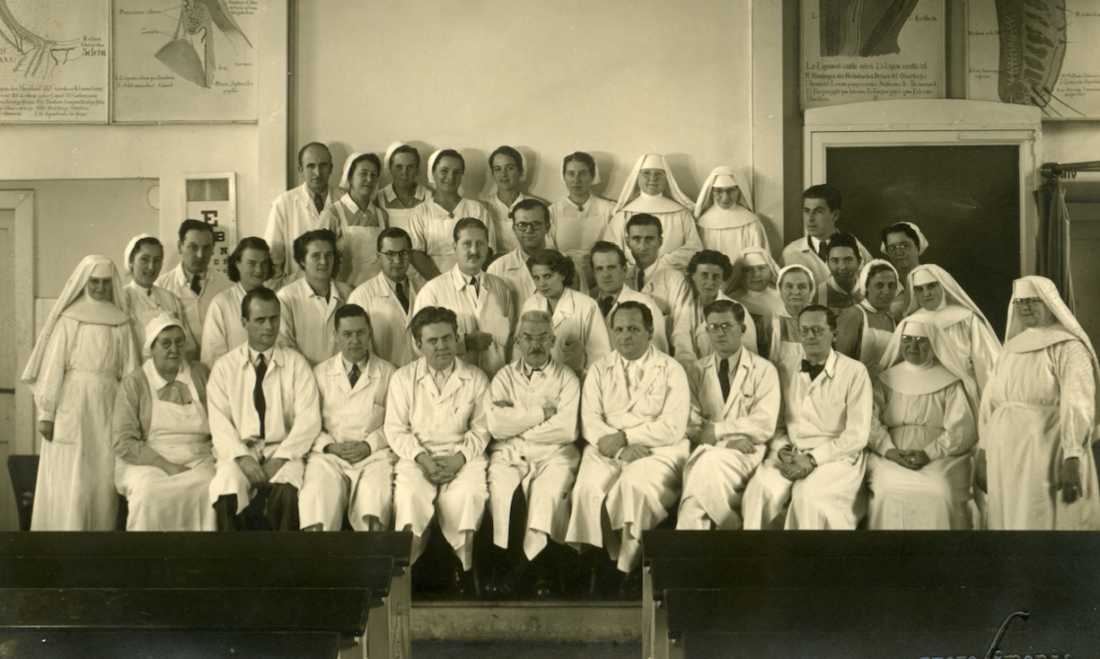A sketch of a lighthouse fills the entire left column on Page 6 of the Asheville Citizen-Times Nov. 21, 1948, Sunday edition. Beams of illustrated light flash out of the tower. Meanwhile, on the top fold, adjacent to the light room, the words read: “Be thankful you can see.”
The full page ad, placed by the Lions Club of Asheville, was part of a fundraising campaign. Nearly two years prior, in January 1947, the organization launched The Western North Carolina Lions Club Eye Clinic. According to the advertisement, the health center was “the only clinic working exclusively with the indigent blind and near-blind in the area.”
At the bottom of the announcement, the organization included the names of its five-member medical staff, which included one Dr. Esperanza Weizenblatt.
Born April 1, 1895, in the former Austro-Hungarian Empire, Weizenblatt studied medicine at the Vienna Eye Clinic. In 1928, after a chance meeting with visiting Asheville ophthalmologist Harry Briggs, Weizenblatt relocated to Western North Carolina, where she joined Briggs’ medical office. By the early 1930s, she launched her own practice inside the Grove Arcade.
Like Weizenblatt, Briggs was also involved in The WNC Lions Club Eye Clinic. In 1955, the organization left its original space inside City Hall and relocated to Memorial Mission Hospital. According to the July 7 announcement, the clinic served more than 10,000 patients from 21 counties during its initial eight-year run.
Weizenblatt’s contributions to the city extended beyond her medical services. For example, on Nov. 28, 1965, the Sunday edition of the Asheville Citizen-Times reported that plans were underway to create a “Garden for the Blind,” located inside the Asheville-Biltmore Botanical Gardens (today’s The Botanical Gardens at Asheville). Though instrumental in its design, Weizenblatt did not publicize her involvement. (Only after her death in 1987 did her role become more widely known.)

Nevertheless, clues pointed to the doctor’s involvement. Namely, the garden’s plan for an acoustic fountain, which the paper wrote was “similar to one that is located in Vienna.”
Updates on the garden continued throughout the latter half of the 1960s. On June 29, 1969, the Sunday edition of the Asheville Citizen-Times reported:
“A special garden for the blind, made possible by an anonymous donor, is now taking shape. This garden is specially designed to appeal to all the senses: touch, taste, smell, hearing, and the large kinetic sense. Trees, shrubs, and plants which have an unusual texture of leaf, bark or flower are featured as well as many plants which have a fragrance of twig or leaf or flower. Some may even be tasted. These are being inconspicuously marked in Braille on a redwood rail.”
Meanwhile, the article continued:
“The pool in the blind garden is copied from one in Vienna, Austria. People may sit on the edge of the pool and feel the spray and water, hear the chimes as the wind blows the spray-drops on seven metal cymbals each sounding a different note, much like Chinese wind chimes.”
Of course, not all of Weizenblatt’s good deeds went unnoticed within her lifetime. On Jan. 13, 1972, The Asheville Citizen reported that the doctor suffered minor injuries and an estimated $600 in car damage when she swerved to avoid hitting a squirrel and instead struck a tree. The rodent, the paper reported, “darted away unharmed.”
Weizenblatt died April 5, 1987, at the age of 92. Three weeks later, in the Saturday edition of The Citizen & Times, staff writer Mona Moore reported on the doctor’s exceptional life. In addition to her professional achievements, Moore spotlighted Weizenblatt’s broad range of interests, which included orchids, hiking, reciting German poetry and surfing (a sport she picked up at age 70).
“Her love of learning and desire to help others has continued after her death in the form of a bequest to UNCA valued at about $500,000,” Moore wrote in the April 25 piece.
“The UNCA Board of Trustees voted four years ago to name the health center for Weizenblatt, who agreed to the designation provided that it not be made public until after her death,” Moore continued.
Today, the Weizenblatt Hall at UNCA and the Weizenblatt Gallery at Mars Hill University are named in her honor.
Editor’s notes: Peculiarities of spelling and punctuation are preserved from original documents.



Thanks to Mr. Calder for spotlighting these local heroes of the past. It appears that the UNCA health center is now in the former MAHEC building on W.T. Weaver. What is the current use of Weizenblatt Hall?
Did Mr. Calder come across any mention of Dr. Weizenblatt’s contribution to Asheville’s architectural history?
Thanks for the comment. According to UNCA, Weizenblatt Hall houses the Public Safety Department which includes university police, emergency management, environmental health & safety, and parking & transportation. I don’t recall coming across anything about Dr. Weizenblatt’s contributions to the city’s architecture. I’m interested in learning more. Thanks again!
Try this: https://breuer.syr.edu/project.php?id=416 for info on the Breuer-Weizenblatt House.